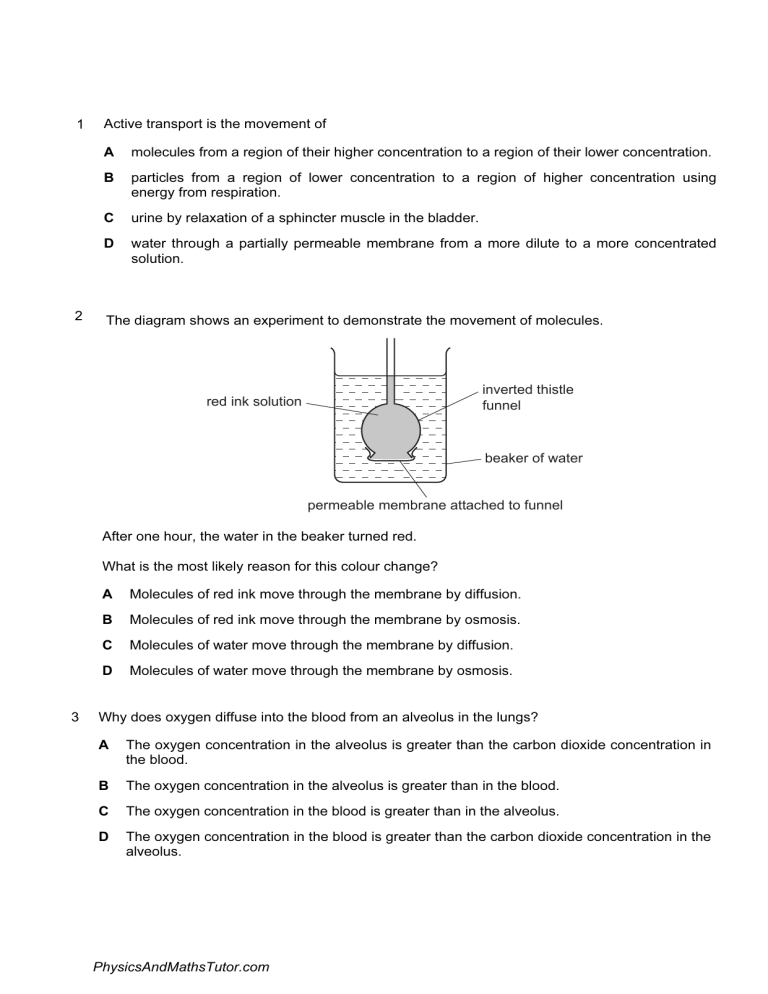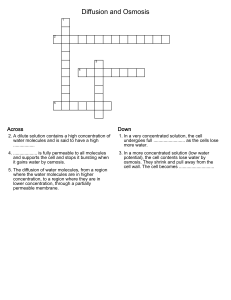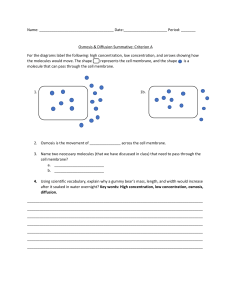
1 2 Active transport is the movement of A molecules from a region of their higher concentration to a region of their lower concentration. B particles from a region of lower concentration to a region of higher concentration using energy from respiration. C urine by relaxation of a sphincter muscle in the bladder. D water through a partially permeable membrane from a more dilute to a more concentrated solution. The diagram shows an experiment to demonstrate the movement of molecules. inverted thistle funnel red ink solution beaker of water permeable membrane attached to funnel After one hour, the water in the beaker turned red. What is the most likely reason for this colour change? 3 A Molecules of red ink move through the membrane by diffusion. B Molecules of red ink move through the membrane by osmosis. C Molecules of water move through the membrane by diffusion. D Molecules of water move through the membrane by osmosis. Why does oxygen diffuse into the blood from an alveolus in the lungs? A The oxygen concentration in the alveolus is greater than the carbon dioxide concentration in the blood. B The oxygen concentration in the alveolus is greater than in the blood. C The oxygen concentration in the blood is greater than in the alveolus. D The oxygen concentration in the blood is greater than the carbon dioxide concentration in the alveolus. PhysicsAndMathsTutor.com 4 The diagram shows water and sugar molecules on either side of a partially permeable membrane. partially permeable membrane key X Y sugar molecule water molecule What happens during osmosis? 5 A More sugar molecules pass through the membrane from X to Y than from Y to X. B More sugar molecules pass through the membrane from Y to X than from X to Y. C More water molecules pass through the membrane from X to Y than from Y to X. D More water molecules pass through the membrane from Y to X than from X to Y. A jar of air was placed upside down on top of a jar containing a brown gas as shown. air air and brown gas brown gas at start Which process has taken place? A diffusion both upwards and downwards B diffusion downwards only C diffusion upwards only D diffusion and osmosis PhysicsAndMathsTutor.com after one hour 6 7 Which statement describes how young plants are supported? A the pressure of water inside the cells pressing outwards on the cell membranes B the pressure of water inside the cells pressing outwards on the cell walls C the pressure of water passing from the roots through the phloem D the pressure of water passing from the roots through the xylem The diagram shows a test-tube containing clear jelly. A drop of blue ink is injected into the middle of the jelly. clear jelly drop of blue ink The blue colour of the ink spreads throughout the jelly. By which process does the blue ink spread through the jelly? 8 A active transport B catalysis C diffusion D osmosis Which diagram shows the changes in appearance of a plant cell when it remains in a concentrated sugar solution for thirty minutes? A B PhysicsAndMathsTutor.com C D 9 The diagram shows a fish in a pond. Why does oxygen diffuse from the air into the water before reaching the fish? A Oxygen is more concentrated in the air than in the water. B Oxygen is more concentrated in the water than in the air. C Oxygen is needed by the fish for aerobic respiration. D Oxygen is needed by the fish for anaerobic respiration. 10 Which structure provides the best surface for diffusion? A atrium B bronchioles C ileum D trachea PhysicsAndMathsTutor.com 11 The diagram shows a plant cell. What is the appearance of this cell after it has been placed in pure water for 30 minutes? A B C D 12 A student cuts out four pieces of carrot root of equal size. The pieces are treated as shown in the diagram, and then left for two hours. After two hours, which piece of carrot will be the smallest? A B water sugar solution boiled carrot PhysicsAndMathsTutor.com C sugar solution boiled carrot D water fresh carrot fresh carrot 13 The diagrams show how a cell appears under the microscope at the start of an experiment and after it has been placed in a dilute solution of salts for 5 minutes. start of the experiment after placing in a dilute solution of salts Which statement explains what happens? A Dissolved salts enter the cell by diffusion. B Dissolved salts leave the cell by diffusion. C Water enters the cell by osmosis. D Water leaves the cell by osmosis. 14 The diagram represents the molecules in two solutions either side of a fully permeable membrane. Key solute molecules water molecules fully permeable membrane In which directions are the net movements of the molecules? solute molecules water molecules A left to right left to right B left to right right to left C right to left left to right D right to left right to left PhysicsAndMathsTutor.com 15 How do carbon dioxide and oxygen move in and out of a mesophyll cell? A active transport B diffusion C respiration D transpiration 16 During osmosis, which molecules move and through which type of membrane? molecules moving type of membrane A oxygen partially permeable B oxygen permeable C water partially permeable D water permeable 17 Which process in humans does not use energy released from respiration? A cell division B diffusion of oxygen C muscle contraction D protein synthesis 18 Which statements are correct for both diffusion and osmosis? involves movement of water only requires energy from the cell molecules move from higher concentration to lower concentration A B C D PhysicsAndMathsTutor.com 19 The diagram shows a plant shoot and the same shoot six hours later. plant shoot same shoot six hours later Which change in environmental conditions could cause this change in the shoot? A a decrease in available water B a decrease in light intensity C a decrease in wind speed D an increase in humidity 20 The diagram shows an experiment set up to investigate osmosis in living cells. water (X) potato glass dish concentrated sugar solution (Y) What happens to the volumes of water (X) and sugar solution (Y) after 12 hours? volume of water (X) volume of sugar solution (Y) A decreases ecreases increases B increases ncreases increases C increases remains the same D remains the same decreases PhysicsAndMathsTutor.com 21 The diagram shows apparatus which can be used to demonstrate osmosis. 1 2 glass tube liquid level very concentrated sucrose solution water concentrated sucrose solution partially permeable membrane After one hour, what would happen to the liquid levels in the glass tubes? 22 By which process does oxygen pass out of a leaf? A diffusion B osmosis C translocation D transpiration PhysicsAndMathsTutor.com 23 Which characteristics are correct for both osmosis and diffusion? 24 How does oxygen move from the alveoli into the blood? A by diffusion B by evaporation C by osmosis D by transpiration 25 Which process occurs by osmosis? A plant roots absorbing mineral ions from the soil B plant roots absorbing water from the soil C the small intestine absorbing fatty acids into the blood D the small intestine absorbing glucose into the blood 26 Red blood cells were placed in a dilute solution. Movement of water across the cell membrane caused a change in their appearance. What explains this movement? PhysicsAndMathsTutor.com 27 The diagram shows a cell. Which type of cell does the diagram show? A an animal cell in a concentrated solution of salts B an animal cell in pure water C a plant cell in a concentrated solution of salts D a plant cell in pure water 28 Two identical cylinders, 40 mm long, are cut from a potato. One (W) is placed in water and the other (X) is placed in a concentrated sugar solution. What are the lengths of the cylinders after two hours? PhysicsAndMathsTutor.com 29 The diagram shows the movement of a concentrated sugar solution up a glass tube. The glass tube is connected firmly to a hollowed-out carrot. at the start after 2 hours glass tube carrot watertight seal concentrated sugar solution dilute sugar solution at the start after two hours Why does the sugar solution in the glass tube rise? A Sugar molecules move across the carrot tissue into the glass tube. B Sugar molecules move across the carrot tissue into the beaker. C Water molecules move across the carrot tissue into the glass tube. D Water molecules move across the carrot tissue into the beaker. 30 A plant absorbs water and oxygen into its roots. How are these substances absorbed? PhysicsAndMathsTutor.com 31 Which diagram shows the appearance of a plant cell several minutes after it has been placed in a concentrated solution of sugar? A B C D 32 The diagrams show an experiment when set up and the same experiment two hours later. when set up two hours later partially permeable membrane concentrated sugar solution coloured with dye pure water What explains the movement of water and dye? movement of water movement of dye A diffusion osmosis B osmosis diffusion C osmosis translocation D translocation diffusion PhysicsAndMathsTutor.com dye has moved into this side 33 The diagram represents two liquids, separated by a membrane through which osmosis can occur. membrane left eft r key molecule of water molecule of dissolved sustance What movement of molecules will occur? A Molecules of dissolved substance move from left to right. B Molecules of dissolved substance move from right to left. C Overall, water molecules move from left to right. D Overall, water molecules move from right to left. 34 The scent from a bunch of flowers spreads throughout a room. How does the scent spread? A by conduction B by diffusion C by osmosis D by transpiration PhysicsAndMathsTutor.com 35 The diagram shows an experiment kept at room temperature. test-tube tubing containing starch, protease, protein and simple sugars distilled water membrane permeable to small molecules only What is present in the water surrounding the membrane after 45 minutes? A amino acids and simple sugars B protein and amino acids C protein and simple sugars D starch and simple sugars 36 Osmosis is defined as the diffusion of water molecules A down their concentration gradient through a partially permeable membrane. B down their concentration gradient through a permeable membrane. C up their concentration gradient through a partially permeable membrane. D up their concentration gradient through a permeable membrane. 37 The diagram shows part of a section through a leaf. Which arrow shows the direction of movement of water by osmosis in a leaf? D A leaf cells B C PhysicsAndMathsTutor.com 38 Which structures must be present in a cell for osmosis to take place? A cell (sap) vacuole and cell wall B cell wall and cell membrane C chloroplast and cytoplasm D cytoplasm and cell membrane 39 A frog’s skin is permeable to oxygen and carbon dioxide. When a frog is swimming in pond water, in which directions will oxygen and carbon dioxide diffuse? 40 from the frog’s skin into the water from the water into the frog’s skin A carbon dioxide oxygen B carbon dioxide and oxygen – C oxygen xygen carbon dioxide D – carbon dioxide and oxygen The diagram shows a fetus attached by the placenta to the uterus wall of the mother. fetus placenta uterus wall By which process do all substances pass between the fetus and the mother in the placenta? A diffusion B nutrition C osmosis D respiration PhysicsAndMathsTutor.com 41 What happens in osmosis? A movement of solute molecules against their concentration gradient B movement of solute molecules down their concentration gradient C movement of water molecules against their concentration gradient D movement of water molecules down their concentration gradient 42 Boiling potatoes destroys their cell membranes. A peeled, boiled potato strip is placed in a concentrated solution of salts. concentrated solution of salts boiled potato strip What takes place? osmosis solute diffusion A key: B = takes place C = does not take place D 43 A red blood cell is placed in a concentrated sugar solution. What happens and why? A The cell bursts as sugar molecules diffuse into it. B The cell bursts because the concentrated sugar solution enters it. C The cell shrinks because sugar molecules leave it. D The cell shrinks because water leaves it. PhysicsAndMathsTutor.com 44 The diagram shows two solutions that are separated by a partially permeable membrane. partially permeable membrane dilute solution of sucrose concentrated solution of sucrose X Y In which direction will most water molecules move in relation to their concentration gradient? 45 A from X to Y against their concentration gradient B from X to Y down their concentration gradient C from Y to X against their concentration gradient D from Y to X down their concentration gradient On a dry, sunny day, how does water vapour move through the stomata of a leaf? A into the leaf by diffusion B into the leaf by osmosis C out of the leaf by diffusion D out of the leaf by osmosis 46 The diagram shows an experiment using a potato. concentrated sugar solution fresh potato water Which shows the result of the experiment after 24 hours? A PhysicsAndMathsTutor.com B C D 47 The dots represent molecules of a gas in four tubes at the beginning of an experiment. In which tube will more molecules move from X to Y than in the opposite direction? X Y A B C D 48 An experiment on diffusion was set up as shown in the diagram. mixture of protein solution and protease partially permeable membrane water at 37 °C What was found in the water after 15 minutes? A amino acids B fatty acids C glucose D glycerol PhysicsAndMathsTutor.com 49 A student investigated osmosis in potatoes. He set up the apparatus shown. potato cylinder P potato cylinder Q scales distilled water very concentrated sugar solution At the beginning the potato cylinders were exactly balanced. He immersed the cylinders into the liquids for 4 hours, after which the cylinders were lifted out of the liquids. Cylinder P was now heavier than cylinder Q. Which statement explains what happened? A Water moved into both cylinders. B Water moved out of both cylinders. C Water moved into the cylinder in the distilled water and out of the cylinder in the sugar solution. D Water moved out of the cylinder in the distilled water and into the cylinder in the sugar solution. 50 An experiment is set up as shown. membrane permeable to iodine molecules mixture of starch and water iodine solution What is the colour of the starch and water mixture after 30 minutes? A blue-black B orange C white D yellow-brown PhysicsAndMathsTutor.com




